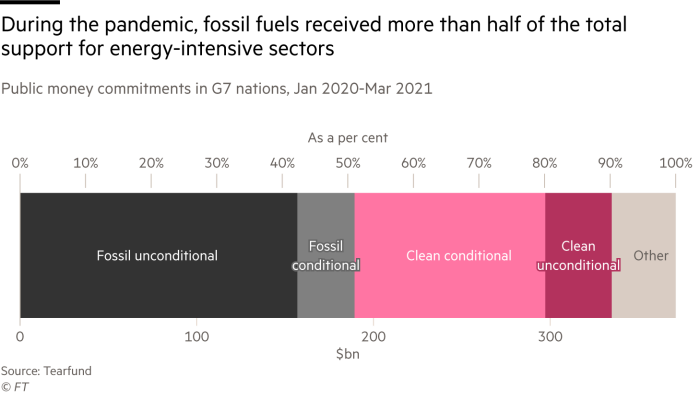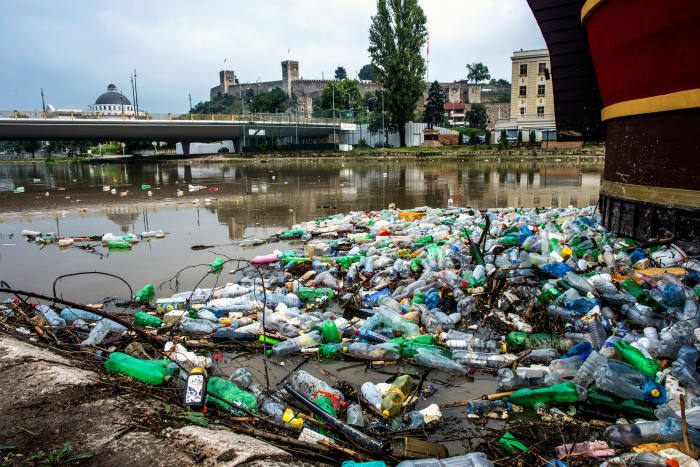Central bank action on climate is ‘imperative’, says Banque de France governor
The ground shifted last week when Big Oil suffered an unprecedented horrible, no good, very bad day.
And another quake may be coming this week from the world of central banking. Beginning today, central bankers from China to the US will join with Christine Lagarde and other notable economists for an unprecedented conference about “green swans” — the fear that climate change poses under-appreciated risks to economies.
The conference attendees will be discussing whether central bankers are barrelling into the climate fight to the detriment of their primary mandates.
In an exclusive interview, France’s central bank governor François Villeroy de Galhau told Moral Money progress had been much quicker than expected on new climate risk disclosure rules and an international framework could be agreed at November’s UN COP26 climate conference in Glasgow, and insisted he that climate risk and inflation concerns were intertwined. Read on. Gillian Tett
PS: last week we asked you whether this proxy season marks a turning point for executive pay. Fifty-three per cent of respondents said no.
Banque de France governor defends climate action
This interview transcript has been edited for length and clarity.
Moral Money: You say [addressing climate risk] is not mission creep but some still worry about interfering with your main mandate, which is price stability. Is it right for the ECB to do this? Is it legal?
François Villeroy: We cannot substitute the necessity of a carbon price, but let me stress why it is not mission creep. On the contrary, it is an imperative for us, consistent with our other mandate of financial stability and price stability.
The clearest message from the NGFS [Network for Greening the Financial System] is to say that climate-related risks are part of financial risks. And so for financial institutions and supervisors as well, it’s not a nice-to-have. It’s not part of [corporate social responsibility]. It is a must-have and it’s part of risk management.
If, as a financial institution, you don’t manage your climate-related risk and if as a supervisor, you don’t look at them [then] you miss your first duty — a duty to financial stability.
MM: Monetary policy is the more controversial area, but it’s probably an area where your impact isn’t going to be as significant as it is through your role as financial supervisor.
FV: There is, as you know, in Europe this question of the secondary mandate — which is about the environment. But let us focus on the primary mandate of price stability. If we had only this primary mandate we would [still] have to deal with climate change — and for obvious reasons because climate change affects economic growth and the level of prices in the long run. Nobody doubts that.
But I can also give you an example in the short run. Three years ago we had a slowdown in German activity with effects on the output gap and on prices and it was due to the low level of the Rhine.
Hence, one of the challenges we have is to better incorporate climate change’s effect on our economic modelling. This is not an easy task. But this is, for me, the first necessary step for greening our monetary policy.
MM: You talked in February about decarbonising the ECB balance sheet and tilting your asset purchases away from the most carbon intensive assets. Can you explain how that would work?
FV: No, this is not exactly what I said. I suggested three tools [for gradual decarbonisation]. The first one is modelling. We have to work on a better analysis of the economic effects of climate change. This raises several serious methodological challenges. We work with the best scientific institutes. We published our first scenarios in June 2020, and will update them each year starting next week.
The second tool I suggested is disclosure. We will have to disclose our climate-related risks, and to impose some disclosure to counterparties, which have a very powerful exemplarity effect.
And third, it is about our operations. For me, we will have to incorporate climate-related risk in the assessment of both our collateral and our asset purchases, but focused on corporations. We have data already on their climate alignment. We should use this data to build progressively to our asset purchases on corporates and our collateral policy.
This is my view, my conviction. We are discussing it in the [ECB] governing council and we will see when Christine Lagarde will publish its review next autumn. And I strongly hope we can go in this direction as quickly as possible.
MM: Will climate risk be incorporated into the capital requirements that are set for banks?
FV: We are not yet there, but the first very important step is to adequately measure climate-related risk in the long run.
What we have learned in our unprecedented [stress test] exercise is that the main risk for banks is transition risk, more than physical risk. Transition risks could increase in 30 years in the long-term view between one-quarter and one-third. We still have to work on the precise measure: I am confident NGFS will deliver on stress test methodology in the year to come.
Is it an orderly transition or a delayed one? We all know we will have to increase carbon prices, the more orderly it is the lower the risks are.
The second dimension is that there is a clear difference in financial institutions that have a static approach to their balance sheets and those that have a dynamic approach. Dynamic meaning I adapt my exposure to climate risk.
It is already a powerful tool for banks themselves to reflect on their strategy and adapt it.
MM: About the Banque de France’s climate stress test results, what surprised you?
FV: The positive surprise was strong voluntary involvement from banks and insurance companies. All big financial institutions took part.
The second surprise perhaps was that we expected insurance companies to have a strong technical advantage over banks because it is long term and they are more used to thinking about climate. It was true for physical risks — without any doubt. But as a general rule, physical risk is limited.
For transition risks, banks were ahead and insurance a bit behind.
Coke’s river clean-up looks beyond the bottle line
Three years ago, Coca-Cola set out to cut its contribution to the world’s glut of plastic waste, saying it would make its packaging fully recyclable by 2025 and recycle one bottle or can for every one it sells by 2030.
Some greeted the pledge sceptically: as the Changing Markets Foundation reported last September, Coke has missed previous recycling targets. But the group behind Sprite and Dasani will take another step towards its “World Without Waste” goals today by unveiling a partnership with The Ocean Cleanup.
Moral Money readers will have seen the TED-talking Boyan Slat explain how he started the project when he was 18 after seeing more plastic bags than fish on a diving trip. He focused first on ocean garbage patches, but started thinking about the arteries that pump plastic into the sea, launching a solar-powered “interceptor” in 2019 to collect flotsam from the world’s 1,000 worst offending rivers.
Slat has rolled out just three of his €550,000 Interceptors but Coke will help take that to 15 over 18 months, with the hope of extending the partnership further.
Slat and Brian Smith, Coca-Cola’s chief operating officer, aren’t saying how much money the company has committed, but they told Moral Money that its connections would be as important as its cash. Coke will mobilise bottlers, the recycling companies it already uses and its government connections to speed deployment.
Whatever the cost, Coke does not regard this as philanthropy. “We see it as a licence to continue operating,” Smith said.
That captures a shift since The Ocean Cleanup began in 2013, Slat says: “Companies recognise more and more that they have an important role to play in society beyond just the bottom line.”
Coke also plans to put its marketing muscle behind an initiative that should provide some good PR. As Smith put it: “We just need to . . . hit people in the heart to say this is something that needs doing.” (Andrew Edgecliffe-Johnson)
Tips from Tamami
Nikkei’s Tamami Shimizuishi helps you stay up to date on stories you may have missed from the eastern hemisphere.
It’s been an exciting time for ESG investors to participate in China’s green transformation, as the world’s largest emitter has become the biggest green bond market in the world, surpassing the US.
But the concern of greenwashing is also rising, despite Beijing’s commitment to achieving net zero by 2060.
China’s carbon neutral bonds fail to restrict the use of funds to green projects, the Institute for Energy Economics and Financial Analysis said, in a warning to ESG investors.
IEEFA’s research found that 30 per cent of proceeds from Yuan-denominated carbon neutral bonds issued by the top state-owned power companies were to be allocated to the working capital of the issuers, whose core businesses were still coal power.
“Chinese financial market regulators need to take a serious look at how the country’s state-owned enterprises are using the proceeds of their green bonds,” said Christina Ng, research and stakeholder engagement leader at IEEFA.
Yi Gang, governor of People’s Bank of China, who has been keen to improve the country’s green finance standards as part of an effort to attract foreign investors, is also participating in the Green Swan conference. We will keep you updated on his remarks on the matter.
Grit in the oyster

Many companies and investors (and governments) say they try to “do well by doing good”. As a reminder that many still fall short, here’s a little grit in the ESG oyster.
Despite government pledges to “build back greener” and cut carbon emissions, more than half of $372bn in Covid recovery funds given by G7 countries to energy-producing and consuming activities was for coal, oil and gas.
And most of the money was handed over “no strings attached” without any demands on the companies receiving help to reduce their carbon footprint.
Further Reading
-
‘Womenomics’ advocate Kathy Matsui debuts venture capital fund (Nikkei)
-
How to Tell if a Company’s Claim of Ethical Practices Is True (NYTimes)
-
MBA graduates take on a green hue as fewer choose fossil fuel careers (FT)
-
Record metals boom may threaten transition to green energy (Guardian)
-
Supervisors step up pressure on banks to tackle climate risk (FT)


